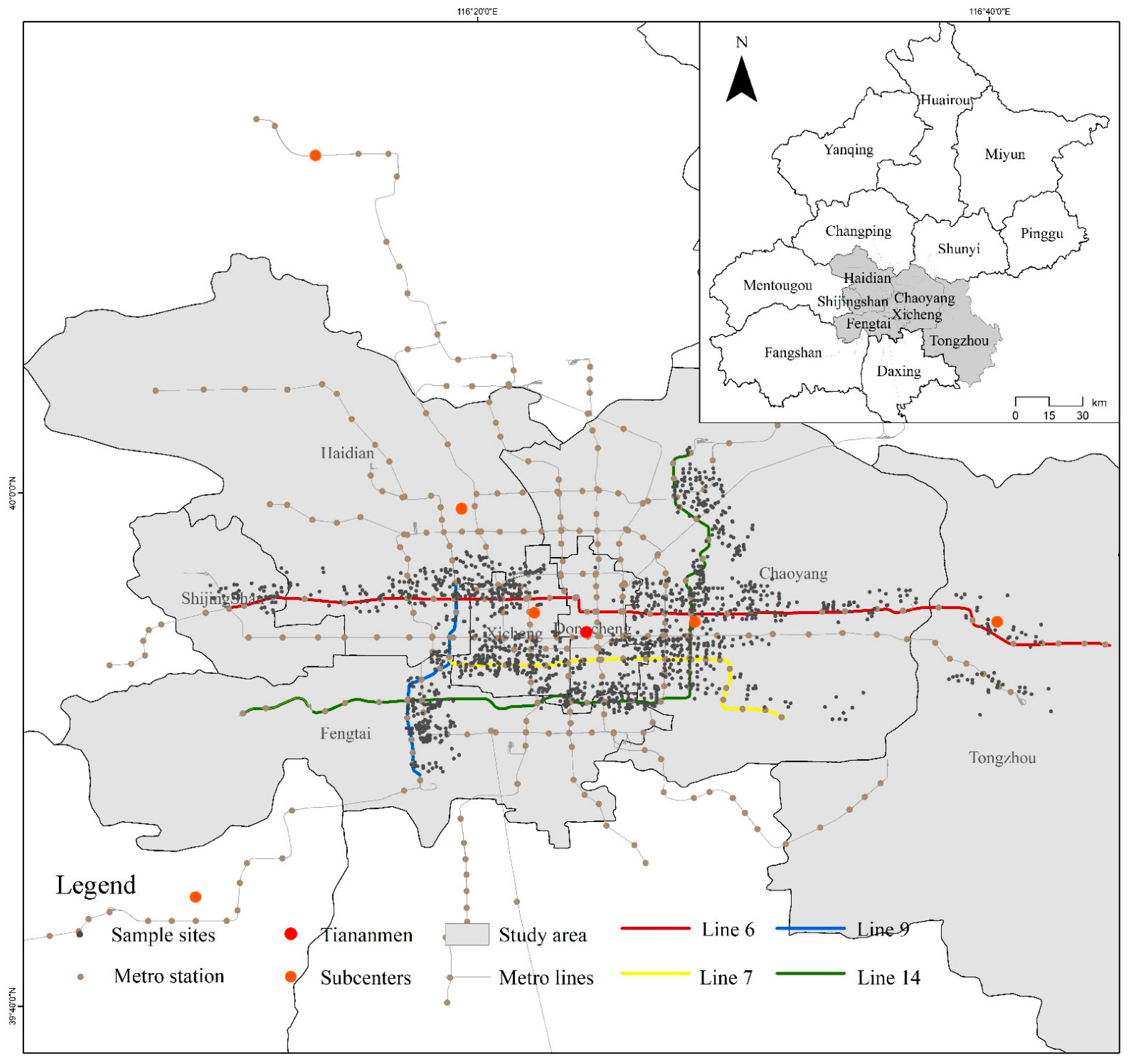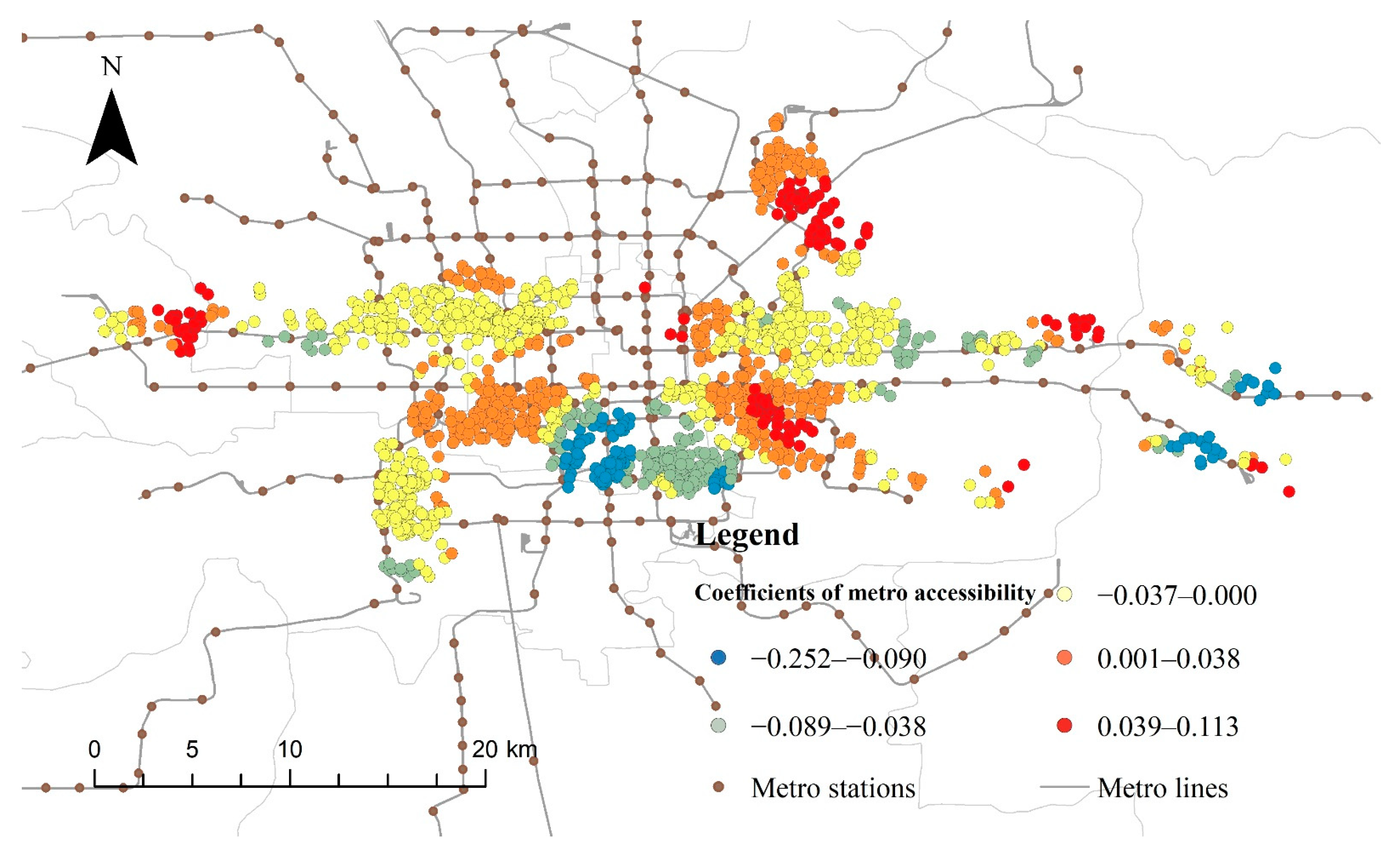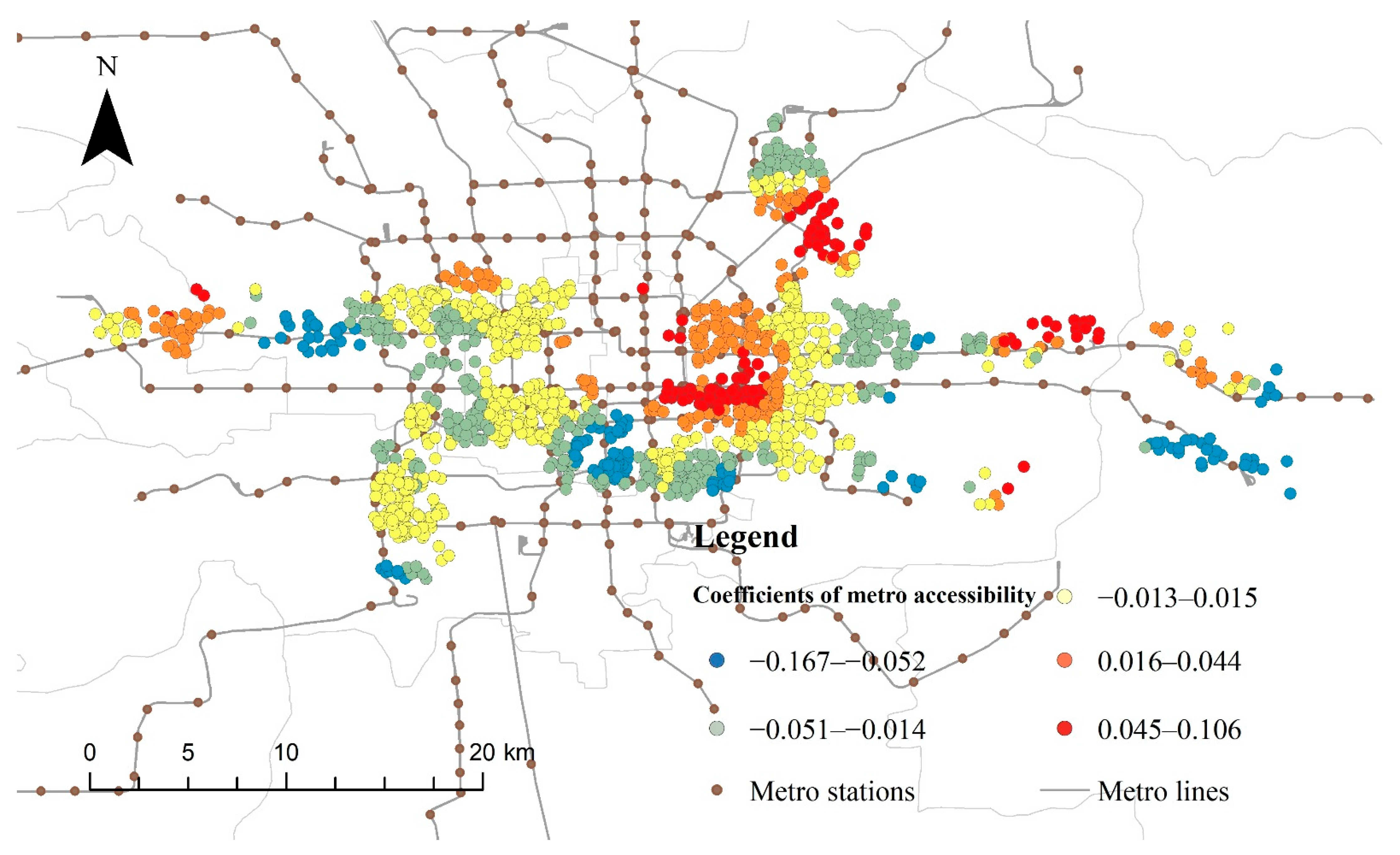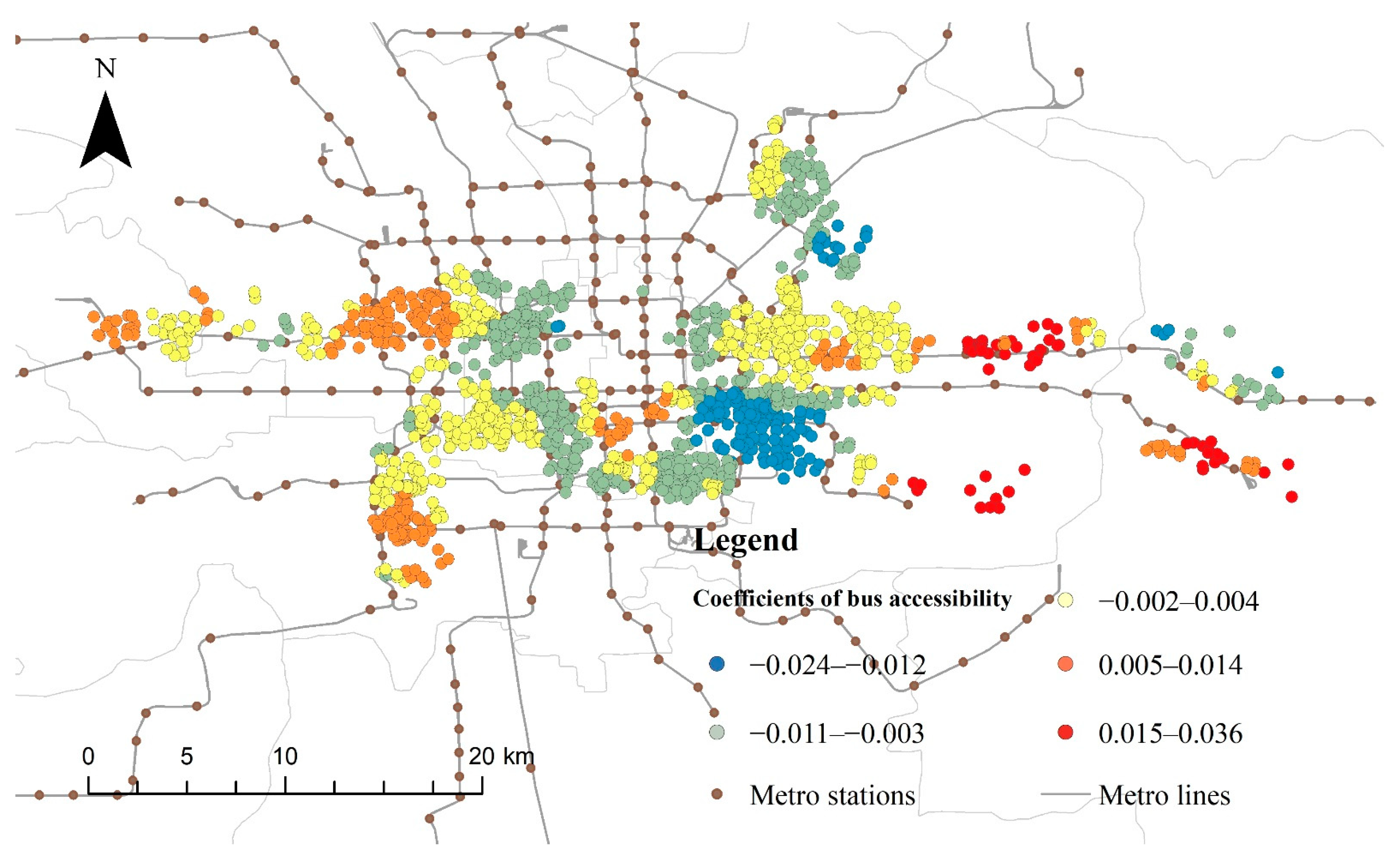Effects of Public Transport Accessibility and Property Attributes on Housing Prices in Polycentric Beijing
Abstract
1. Introduction
2. Materials and Methods
2.1. Study Area
2.2. Data Sources
2.3. Data Analysis
2.3.1. Ordinary Least Squares (OLS) Regression
- : the average housing price of ith residence;
- : the constant estimated for the model;
- , , , : the coefficients of public transport accessibility, building features, location characteristics and neighborhood amenities.
- : the public transport accessibility variable of ith residence;
- : the building features variable of ith residence;
- : the location characteristics variable of ith residence;
- : the neighborhood amenities variable of ith residence
- : random error.
2.3.2. Geographically Weighted Regression (GWR)
- : the coordinates of ith residence;
- : the average housing price of ith residence;
- : the constant;
- : the kth explanatory variable of ith residence;
- : the coefficients of ;
- : the random error;
- n: sample number.
- : the estimated value of the regression coefficient column vector (p × 1) at ;
- : the explanatory variable for the sample point (n × p);
- : the spatial weight matrix (n × n) based on the principle of distance attenuation;
- : the housing prices column vector (n × 1) for the sample point.
3. Results
3.1. Performance of Monocentric and Polycentric OLS Models at the Global Scale
3.2. Performance of Monocentric and Polycentric GWR Models
3.3. Spatial Patterns of the Premiums of Public Transit Accessibility
4. Discussion
4.1. Comparison of OLS and GWR Regression Models
4.2. Differences in Premium Effects of Public Transit Accessibility
5. Conclusions
Author Contributions
Funding
Conflicts of Interest
References
- Gadzinski, J.; Radzimski, A. The first rapid tram line in Poland: How has it affected travel behaviours, housing choices and satisfaction, and apartment prices? J. Transp. Geogr. 2016, 54, 451–463. [Google Scholar] [CrossRef]
- Lan, F.; Wu, Q.; Zhou, T.; Da, H. Spatial Effects of Public Service Facilities Accessibility on Housing Prices: A Case Study of Xi’an, China. Sustainability 2018, 10, 4503. [Google Scholar] [CrossRef]
- Liebelt, V.; Bartke, S.; Schwarz, N. Urban Green Spaces and Housing Prices: An Alternative Perspective. Sustainability 2019, 11, 3707. [Google Scholar] [CrossRef]
- Yu, D. A Spatial Analysis of Real Estate Prices and Public Transportation in the Greater Los Angeles Area; University of Southern California: Los Angeles, CA, USA, 2014. [Google Scholar]
- Cui, N.N.; Gu, H.Y.; Shen, T.Y.; Feng, C.C. The Impact of Micro-Level Influencing Factors on Home Value: A Housing Price-Rent Comparison. Sustainability 2018, 10, 4343. [Google Scholar] [CrossRef]
- Tan, R.H.; He, Q.S.; Zhou, K.H.; Xie, P. The effect of new metro stations on local land use and housing prices: The case of Wuhan, China. J. Transp. Geogr. 2019, 79, 102488. [Google Scholar] [CrossRef]
- Zhang, D.; Jiao, J. How does urban rail transit influence residential property values? Evidence from an emerging Chinese megacity. Sustainability 2019, 11, 534. [Google Scholar] [CrossRef]
- Wen, H.Z.; Zhang, Y.; Zhang, L. Do educational facilities affect housing price? An empirical study in Hangzhou, China. Habitat Int. 2014, 42, 155–163. [Google Scholar] [CrossRef]
- Wu, C.; Ye, X.Y.; Du, Q.Y.; Luo, P. Spatial effects of accessibility to parks on housing prices in Shenzhen, China. Habitat Int. 2017, 63, 45–54. [Google Scholar] [CrossRef]
- Jim, C.Y.; Chen, W.Y. Impacts of urban environmental elements on residential housing prices in Guangzhou (China). Landsc. Urban Plan. 2006, 78, 422–434. [Google Scholar] [CrossRef]
- Zietz, J.; Zietz, E.N.; Sirmans, G.S. Determinants of House Prices: A Quantile Regression Approach. J. Real Estate Financ. Econ. 2008, 37, 317–333. [Google Scholar] [CrossRef]
- Dziauddin, M.; Powe, N.; Alvanides, S. Estimating the effects of Light Rail Transit (LRT) System on residential property values using Geographically Weighted Regression (GWR). Appl. Spat. Anal. Policy 2015, 8, 1–25. [Google Scholar] [CrossRef]
- Li, S.; Chen, L.; Zhao, P.J. The impact of metro services on housing prices: A case study from Beijing. Transportation 2019, 46, 1291–1317. [Google Scholar] [CrossRef]
- Beijing Municipal Bureau of Statistics. Beijing Statistical Yearbook 2020; Beijing Municipal Bureau of Statistics: Beijing, China, 2020.
- Tan, Z.; Chen, M. International empirical evidence on house price volatility and financial crises: Collateral or deviation effects. J. World Econ. 2012, 35, 146–159. [Google Scholar]
- Dai, X.Z.; Bai, X.; Xu, M. The influence of Beijing rail transfer stations on surrounding housing prices. Habitat Int. 2016, 55, 79–88. [Google Scholar] [CrossRef]
- Zhang, X.Q.; Zheng, Y.Q.; Sun, L.; Dai, Q.W. Urban Structure, Subway System and Housing Price: Evidence from Beijing and Hangzhou, China. Sustainability 2019, 11, 669. [Google Scholar] [CrossRef]
- Dadashpoor, H.; Malekzadeh, N. Driving factors of formation, development, and change of spatial structure in metropolitan areas: A systematic review. J. Urban Manag. 2020, 9, 286–297. [Google Scholar] [CrossRef]
- Huang, D.Q.; Liu, Z.; Zhao, X.S.; Zhao, P.J. Emerging polycentric megacity in China: An examination of employment subcenters and their influence on population distribution in Beijing. Cities 2017, 69, 36–45. [Google Scholar] [CrossRef]
- Zou, Y.H.; Mason, R.; Zhong, R.J. Modeling the polycentric evolution of post-Olympic Beijing: An empirical analysis of land prices and development intensity. Urban Geogr. 2015, 36, 735–756. [Google Scholar] [CrossRef]
- Ottensmann, J.; Payton, S.; Man, J. Urban location and housing prices within a hedonic model. J. Reg. Anal. Policy 2008, 38, 19–35. [Google Scholar]
- Liu, Z.; Liu, S.H. Polycentric Development and the Role of Urban Polycentric Planning in China’s Mega Cities: An Examination of Beijing’s Metropolitan Area. Sustainability 2018, 10, 1588. [Google Scholar] [CrossRef]
- Xu, T.; Zhang, M.; Aditjandra, P.T. The impact of urban rail transit on commercial property value: New evidence from Wuhan, China. Transp. Res. Part A Policy Pract. 2016, 91, 223–235. [Google Scholar] [CrossRef]
- Henneberry, J. Transport investment and house prices. J. Prop. Valuat. Invest. 1998, 16, 144–158. [Google Scholar] [CrossRef]
- Bajic, V. The Effects of a New Subway Line on Housing Prices in Metropolitan Toronto. Urban Stud. 1983, 20, 147–158. [Google Scholar] [CrossRef]
- Bowes, D.R.; Ihlanfeldt, K.R. Identifying the impacts of rail transit stations on residential property values. J. Urban Econ. 2001, 50, 1–25. [Google Scholar] [CrossRef]
- Haider, M.; Miller, E.J. Effects of transportation infrastructure and location on residential real estate values—Application of spatial autoregressive techniques. Transp. Res. Rec. 2000, 1722, 1–8. [Google Scholar] [CrossRef]
- Nie, C.; Wen, H.; Fan, X. The spatial and temporal effect on property value increment with the development of urban rapid rail transit: An empirical research. Geogr. Res. 2010, 29, 801–810. [Google Scholar]
- Feng, C.; Li, W.; Zhao, F. Influence of rail transit on nearby commodity housing prices: A case study of Beijing subway line five. Acta Geogr. Sin. 2011, 66, 1055–1062. [Google Scholar]
- Yang, L.; Chen, Y.; Xu, N.; Zhao, R.; Chau, K.W.; Hong, S. Place-varying impacts of urban rail transit on property prices in Shenzhen, China: Insights for value capture. Sustain. Cities Soc. 2020, 58, 102140. [Google Scholar] [CrossRef]
- Deng, T.; Nelson, J. The impact of bus rapid transit on land development: A case study of Beijing, China. World Acad. Sci. Eng. Technol. 2010, 66, 1196–1206. [Google Scholar]
- Zhang, M.; Meng, X.; Wang, L.; Xu, T. Transit development shaping urbanization: Evidence from the housing market in Beijing. Habitat Int. 2014, 44, 545–554. [Google Scholar] [CrossRef]
- Gu, Y.; Guo, R. The impacts of the rail transit on property values: Empirical study in Batong line of Beijing. Econ. Geogr. 2008, 28, 411–414. [Google Scholar]
- Available online: https://www.python.org/ (accessed on 15 January 2021).
- Available online: https://beijing.anjuke.com/ (accessed on 1 February 2021).
- Available online: https://map.baidu.com/ (accessed on 20 February 2021).
- Oshan, T.M.; Li, Z.; Kang, W.; Wolf, L.J.; Fotheringham, A.S. MGWR: A Python Implementation of Multiscale Geographically Weighted Regression for Investigating Process Spatial Heterogeneity and Scale. ISPRS Int. J. Geo-Inf. 2019, 8, 269. [Google Scholar] [CrossRef]
- Esri. ArcGIS Help 10.1.; Esri: Redlands, CA, USA, 2013. [Google Scholar]
- Brunsdon, C.; Fotheringham, S.; Charlton, M. Geographically weighted regression-modelling spatial non-stationarity. J. R. Stat. Soc. D-Sta. 1998, 47, 431–443. [Google Scholar]
- Wang, Q.; Ni, J.; Tenhunen, J. Application of a geographically-weighted regression analysis to estimate net primary production of Chinese forest ecosystems. Glob. Ecol. Biogeogr. 2005, 14, 379–393. [Google Scholar] [CrossRef]
- Wu, R. A Research on Spatial Heterogeneity and Affecting Factors of Second-Hand Real Estate Prices in Beijing Based on GWR Model; University of International Business and Economics: Beijing, China, 2018. [Google Scholar]
- The 2018 Big Data Urban Activity Report of Beijing. 2022. Available online: https://www.cbndata.com/report/1081/detail?isReading=report&page=7/ (accessed on 20 March 2020).
- Zhou, Y.; Zheng, S.; Hu, Z.; Chen, Y. Metro station risk classification based on smart card data: A case study in Beijing. Phys. A Stat. Mech. Its Appl. 2022, 594, 127019. [Google Scholar] [CrossRef]
- Lyu, G.; Bertolini, L.; Pfeffer, K. Is labour productivity higher in transit oriented development areas? A study of Beijing. Tijdschr. Voor Econ. En Soc. Geogr. 2020, 111, 652–670. [Google Scholar] [CrossRef]
- Sisman, S.; Aydinoglu, A.C. A modelling approach with geographically weighted regression methods for determining geographic variation and influencing factors in housing price: A case in Istanbul. Land Use Policy 2022, 119, 106183. [Google Scholar] [CrossRef]
- Eliasson, J.; Kopsch, F.; Mandell, S.; Wilhelmsson, M. Transport Mode and the Value of Accessibility—A Potential Input for Sustainable Investment Analysis. Sustainability 2020, 12, 2143. [Google Scholar] [CrossRef]
- Duncan, M. The Impact of Transit-Oriented Development on Housing Prices in San Diego, CA. Urban Stud. 2011, 48, 101–127. [Google Scholar] [CrossRef]
- Gu, Y.; Zheng, S. The impacts of rail transit on property values and land development intensity: The case of no. 13 line in Beijing. Acta Geogr. Sin. 2010, 65, 213–223. [Google Scholar]
- Huang, D.Q.; Yang, X.Q.; Liu, Z.; Zhao, X.S.; Kong, F.H. The Dynamic Impacts of Employment Subcenters on Residential Land Price in Transitional China: An Examination of the Beijing Metropolitan Area. Sustainability 2018, 10, 1016. [Google Scholar] [CrossRef]
- Su, S.; Zhang, J.; He, S.; Zhang, H.; Hu, L.; Kang, M. Unraveling the impact of TOD on housing rental prices and implications on spatial planning: A comparative analysis of five Chinese megacities. Habitat Int. 2021, 107, 102309. [Google Scholar] [CrossRef]
- Shen, Q.; Xu, S.M.; Lin, J. Effects of bus transit-oriented development (BTOD) on single-family property value in Seattle metropolitan area. Urban Stud. 2018, 55, 2960–2979. [Google Scholar] [CrossRef]
- Zhang, M. Chinese edition of transit-oriented development. Transp. Res. Rec. 2007, 2038, 120–127. [Google Scholar] [CrossRef]
- Bhat, C.; Handy, S.; Kockelman, K.; Mahmassani, H.; Chen, Q.; Weston, L. Urban Accessibility Index: Literature Review; U.S. Department of Transportation: Washington, DC, USA, 2000.
- Martinez, L.M.; Viegas, J.M. Effects of Transportation Accessibility on Residential Property Values Hedonic Price Model in the Lisbon, Portugal, Metropolitan Area. Transp. Res. Rec. 2009, 2115, 127–137. [Google Scholar] [CrossRef]
- Yang, L.C.; Chau, K.W.; Szeto, W.Y.; Cui, X.; Wang, X. Accessibility to transit, by transit, and property prices: Spatially varying relationships. Transp. Res. Part D Transp. Environ. 2020, 85, 102387. [Google Scholar] [CrossRef]
- Mulley, C.; Tsai, C. Impact of bus rapid transit on housing price and accessibility changes in Sydney: A repeat sales approach. Int. J. Sustain. Transp. 2017, 11, 3–10. [Google Scholar] [CrossRef]





| Variable Type | Residence Factor Set | Variable Name | Explanation | Assumed Effect a |
|---|---|---|---|---|
| Dependent | Housing price | Housing price | Housing price per square meter (Yuan) b | |
| Independent | Public transport accessibility | Bus accessibility | Number of bus stops within an 800 m radius | + |
| Metro accessibility | Number of metro stations within a 1200 m radius | + | ||
| Distance to metro station | Distance to the nearest metro station (m) | - | ||
| Building features | Building age | Building age by 2022 (year) | - | |
| Property management fee | Residence property management fee (Yuan) | + | ||
| Green cover | Ratio of green space to total site area (%) | + | ||
| Plot ratio | Ratio of total above-ground floor area to total site area (%) | - | ||
| Location characteristics | Distance to monocenter | Distance to Tiananmen Square (m) | - | |
| Distance to subcenter | Distance to the nearest subcenter (m) | - | ||
| Neighborhood amenities | Distance to school | Distance to the nearest public school (m) c | - | |
| Distance to hospital | Distance to the nearest non-profit hospital (m) | - | ||
| Distance to market | Distance to the nearest market (m) | - | ||
| Distance to park | Distance to the nearest park (m) | - |
| Variable | Monocentric Model | Polycentric Model | ||||
|---|---|---|---|---|---|---|
| Coefficient a,b | Standardized Coefficients | VIF b,c | Coefficient a,b | Standardized Coefficients | VIF b,c | |
| Bus accessibility | 0.01 *** | 0.06 *** | 1.05 | 0.00 *** | 0.05 ** | 1.08 |
| Metro accessibility | 0.03 *** | 0.09 *** | 1.19 | 0.07 *** | 0.21 *** | 1.11 |
| Distance to metro station | # | # | # | # | # | # |
| Building age | −0.05 *** | −0.07 *** | 1.17 | −0.04 *** | −0.06 *** | 1.19 |
| Property management fee | 0.11 *** | 0.24 *** | 1.29 | 0.11 *** | 0.25 *** | 1.08 |
| Green cover | # | # | # | # | # | |
| Plot ratio | −0.09 *** | −0.12 *** | 1.17 | −0.06 *** | −0.08 *** | 1.17 |
| Distance to monocenter | −0.34 *** | −0.55 *** | 1.27 | # | # | |
| Distance to polycenter | # | # | # | −0.14 *** | −0.26*** | 1.16 |
| Distance to school | # | # | # | −0.05 *** | −0.10 *** | 1.09 |
| Distance to hospital | # | # | # | −0.07 *** | −0.15 *** | 1.08 |
| Distance to market | # | # | # | # | # | # |
| Distance to park | −0.05 *** | −0.09 *** | 1.04 | −0.07 *** | −0.14 *** | 1.04 |
| Constant | 14.62 *** | # | # | 13.54 *** | # | # |
| Adjusted R2 | 0.43 | 0.29 | ||||
| AICc d | 92.77 | 425.54 | ||||
| Moran’s I for residuals e | 0.579 | 0.628 | ||||
| Variable | Mean | Maximum | Minimum | Standard Deviation | Lower Quartile | Median | Upper Quartile |
|---|---|---|---|---|---|---|---|
| Metro accessibility | −0.011 | 0.113 | −0.252 | 0.044 | −0.028 | −0.007 | 0.014 |
| Bus accessibility | −0.001 | 0.037 | −0.025 | 0.008 | −0.006 | −0.002 | 0.003 |
| Property management fee | −0.069 | 0.178 | −0.366 | 0.064 | 0.052 | 0.079 | 0.119 |
| Plot ratio | 0.084 | 0.279 | −0.049 | 0.050 | −0.109 | −0.065 | −0.031 |
| Building Age | −0.073 | 0.119 | −0.370 | 0.066 | −0.110 | −0.073 | −0.021 |
| Accessibility to park | −0.012 | 0.152 | −0.411 | 0.063 | −0.038 | −0.010 | 0.020 |
| Accessibility to monocenter | −0.410 | 1.065 | −3.583 | 0.329 | −0.582 | −0.380 | −0.285 |
| Intercept | 15.227 | 49.809 | 2.472 | 3.131 | 14.020 | 15.006 | 16.590 |
| Local R2 | 0.616 | 0.977 | 0.299 | 0.124 | 0.539 | 0.604 | 0.694 |
| Adjusted R2 | 0.805 | ||||||
| AICc | −1021.558 | ||||||
| Moran’s I for Residual | 0.041 |
| Variable | Mean | Maximum | Minimum | Standard Deviation | Lower Quartile | Median | Upper Quartile |
|---|---|---|---|---|---|---|---|
| Metro accessibility | −0.004 | 0.106 | −0.167 | 0.035 | −0.022 | −0.002 | 0.014 |
| Bus accessibility | −0.002 | 0.036 | −0.024 | 0.008 | −0.006 | −0.002 | 0.002 |
| Property management fee | 0.082 | 0.237 | −0.048 | 0.051 | 0.048 | 0.074 | 0.120 |
| Plot ratio | −0.071 | 0.189 | −0.427 | 0.064 | −0.107 | −0.072 | −0.033 |
| Building Age | −0.073 | 0.075 | −0.401 | 0.065 | −0.114 | −0.074 | −0.021 |
| Accessibility to school | −0.003 | 0.100 | −0.102 | 0.037 | −0.027 | −0.005 | 0.014 |
| Accessibility to hospital | −0.008 | 0.137 | −0.187 | 0.049 | −0.043 | −0.012 | 0.021 |
| Accessibility to park | −0.010 | 0.131 | −0.422 | 0.064 | −0.034 | −0.004 | 0.018 |
| Accessibility to subcenter | −0.249 | 0.165 | −0.886 | 0.239 | −0.430 | −0.196 | −0.050 |
| Intercept | 13.793 | 20.367 | 9.002 | 1.965 | 12.387 | 13.450 | 15.113 |
| Local R2 | 0.638 | 0.982 | 0.330 | 0.118 | 0.568 | 0.631 | 0.710 |
| Adjusted R2 | 0.805 | ||||||
| AICc | −876.125 | ||||||
| Moran’s I of Residual | 0.047 |
Publisher’s Note: MDPI stays neutral with regard to jurisdictional claims in published maps and institutional affiliations. |
© 2022 by the authors. Licensee MDPI, Basel, Switzerland. This article is an open access article distributed under the terms and conditions of the Creative Commons Attribution (CC BY) license (https://creativecommons.org/licenses/by/4.0/).
Share and Cite
Zhou, Y.; Tian, Y.; Jim, C.Y.; Liu, X.; Luan, J.; Yan, M. Effects of Public Transport Accessibility and Property Attributes on Housing Prices in Polycentric Beijing. Sustainability 2022, 14, 14743. https://doi.org/10.3390/su142214743
Zhou Y, Tian Y, Jim CY, Liu X, Luan J, Yan M. Effects of Public Transport Accessibility and Property Attributes on Housing Prices in Polycentric Beijing. Sustainability. 2022; 14(22):14743. https://doi.org/10.3390/su142214743
Chicago/Turabian StyleZhou, Yuchen, Yuhong Tian, Chi Yung Jim, Xu Liu, Jingya Luan, and Mengxuan Yan. 2022. "Effects of Public Transport Accessibility and Property Attributes on Housing Prices in Polycentric Beijing" Sustainability 14, no. 22: 14743. https://doi.org/10.3390/su142214743
APA StyleZhou, Y., Tian, Y., Jim, C. Y., Liu, X., Luan, J., & Yan, M. (2022). Effects of Public Transport Accessibility and Property Attributes on Housing Prices in Polycentric Beijing. Sustainability, 14(22), 14743. https://doi.org/10.3390/su142214743







